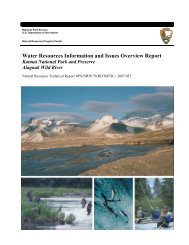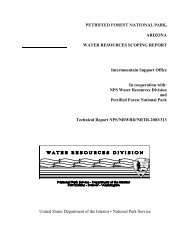ENVIRONMENTAL CONTAMINANTS ENCYCLOPEDIA ...
ENVIRONMENTAL CONTAMINANTS ENCYCLOPEDIA ...
ENVIRONMENTAL CONTAMINANTS ENCYCLOPEDIA ...
Create successful ePaper yourself
Turn your PDF publications into a flip-book with our unique Google optimized e-Paper software.
egarding the carcinogenic effects resulting from<br />
naphthalene exposure. There is some evidence that<br />
naphthalene causes lung cancer in female mice but<br />
not in male mice, or rats of either sex [867]. The<br />
EPA has determined that naphthalene is not<br />
classifiable as to its human carcinogenicity based<br />
on the absence of animal data [766].<br />
The observations of Adkins et al. (1986) that there<br />
was an increased incidence of tumors in each tumorbearing<br />
mouse, but not in the numbers of mice with<br />
tumors, supports classifying naphthalene as a<br />
promoter for lung tumors rather than a carcinogen.<br />
If this hypothesis is correct, naphthalene may be<br />
of greatest environmental concern when exposure to<br />
naphthalene is accompanied by exposure to pulmonary<br />
carcinogens [766]. This is of interest because<br />
naphthalene occurs in various petroleum fuel<br />
mixtures which also contain know carcinogens such<br />
as benzene, 1,3 butadiene, and various carcinogenic<br />
PAHs.<br />
Naphthalene was predicted not to be phototoxic using QSAR<br />
estimates [891].<br />
Some interactions are known for certain naphthalenes.<br />
For example, when either naphthalene, 1methylnaphthalene,<br />
of 2-methylnaphthalene was applied<br />
dermally in combination with benzo(a)pyrene (BaP), there<br />
was an inhibitory effect on the induction of skin tumors<br />
in female mice. The authors suggested that it is likely<br />
that certain naphthalenes compete with BaP for the same<br />
enzyme site, resulting in alteration of the BaP metabolic<br />
pathway and decreased production of the active BaP<br />
metabolite [766].<br />
Naphthalene often occurs together with other PAHs, in<br />
complex mixtures possibly more carcinogenic than the<br />
individual components (see "PAHs as a group" entry). The<br />
debates on exactly how to perform both ecological and<br />
human risk assessments on the complex mixtures of PAHs<br />
typically found at contaminated sites, are likely to<br />
continue. There are some clearly wrong ways to go about<br />
it, but defining clearly right ways is more difficult.<br />
PAHs such as naphthalene usually occur in complex<br />
mixtures rather than alone. One of the few things that<br />
seems clear is that complex PAH mixtures in water,<br />
sediments, and organism internal tissues may be<br />
carcinogenic and/or phototoxic (Roy Irwin, National Park<br />
Service, personal communication, 1996; see also "PAHs as<br />
a group" entry and Arfsten et al [911]).<br />
One way to approach site specific risk assessments is to<br />
collect the complex mixture of PAHs and other lipophilic

















